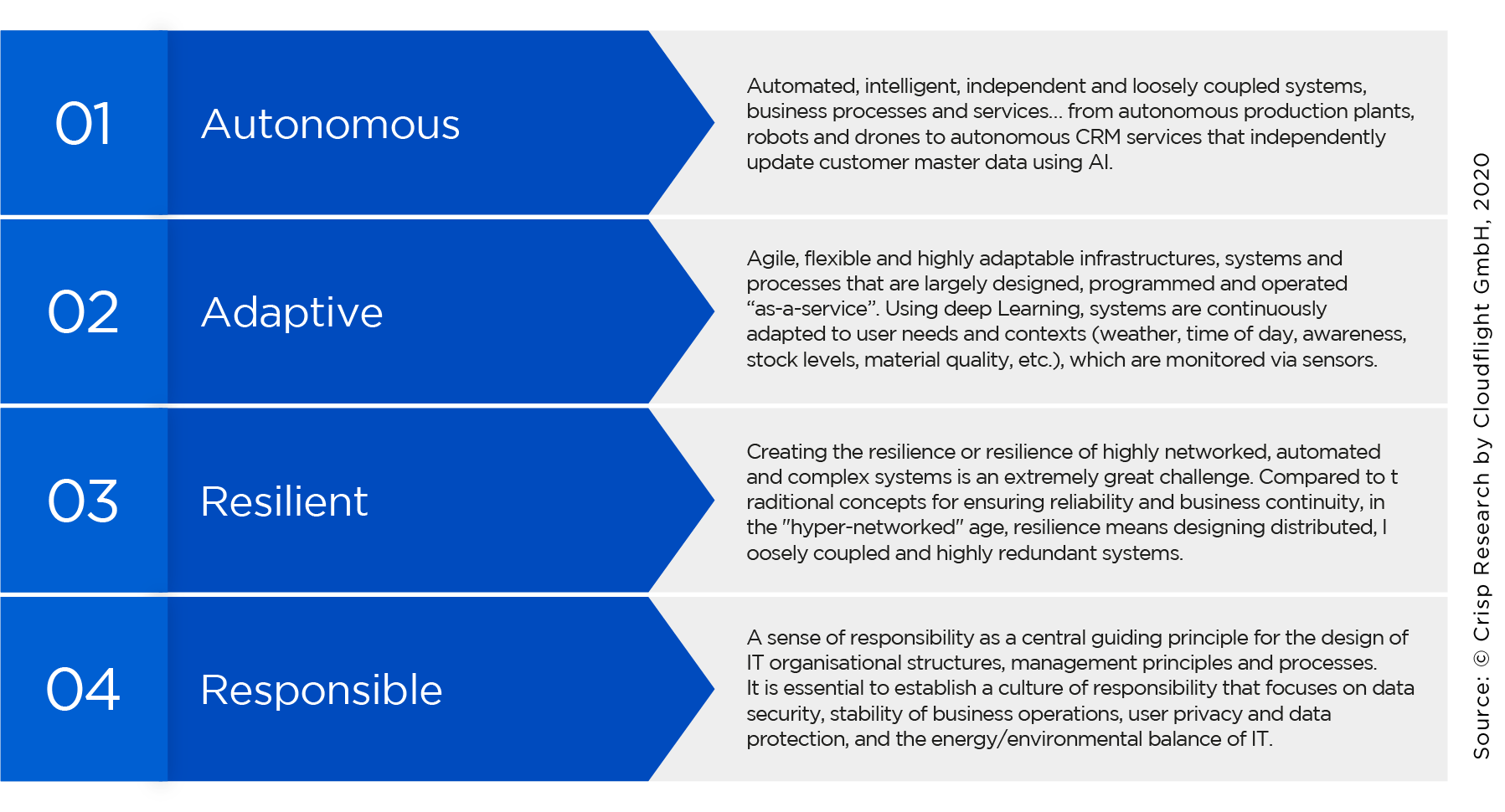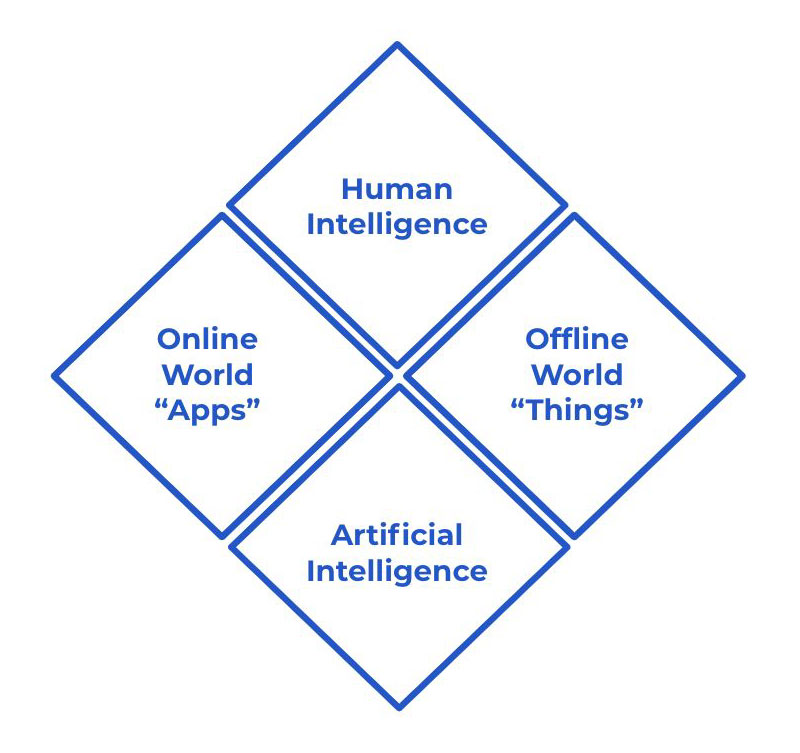Why European companies need to complete the digital transformation to remain viable and competitive
- Corona as a digitalization turbo – In almost all areas of life and the economy, digitalization is proving to be a lifeline anchor and catalyst for creative and solidarity-based solutions in the crisis.
- CEOs must complete digital transformation – The viability and competitiveness of companies are directly linked to the degree of digitalization. Many companies in Europe are still poorly positioned digitally in 2020. CEOs, together with their CIOs and CDOs, are therefore obliged to drive forward and complete the digital transformation.
- Reset or reboot? How to reboot business and IT after the crisis? There can be no “business as usual” after the crisis. IT and business processes must become leaner, more agile and more automated. Existing organizational and management models as well as IT operating concepts must be put to the test in the short term!
- IT 2030 – Digital resilience and hybrid organisation – Digitalization can make companies more resilient in crises. Therefore, IT should become more autonomous, automated and agile. Analogous to the IT infrastructure (“hybrid cloud”), corporate and IT organizations are increasingly becoming “hybrid”. Algorithms and autonomous machines will take their place alongside people and applications or business processes.
Corona as a disruptive force and digitalization turbo
“Breakthrough for digitalization”, “How the virus makes digitalization move forward” or “Corona makes the Internet a matter of course” – this is how the headlines of articles describing the effects of the coronavirus on the digitalization of various areas of life are currently read.
- Home office: Almost all companies allow flexible working from home; video conferencing is becoming a matter of course.
- Digital classroom: As schools, kindergartens and universities are closed for the time being, eLearning is becoming a mass phenomenon and is currently being experimented a lot – even if the “digitalization gap” in areas of schools is still blatant.
- Online medicine: Information and diagnosis are shifting almost massively to digital channels. New forms of care and support are emerging.
- Entertainment & culture: Concerts and events are taking place virtually; online streaming is causing the biggest peak in internet traffic ever measured at the Frankfurt exchange node DE-CIX: 9.1 Terabit/s!
- Social life: In times of “social distancing”, digital media and the Internet play an immanently important role for private and social networking and social solidarity. Thus even the problems with “fake news” fade into the background.
- Digital town hall: Authorities and public institutions are restricting public access and expanding digital contact points and services.
The corona crisis clearly represents a turning point in the digitalization of the economy and society. While there has been much discussion in recent years about the disruptive power of digitalization but too little action, the current crisis shows the true nature of digital innovation. These make companies and organizations adaptable, capable of action and thus able to survive the crisis. Digital innovation is therefore synonymous with “digital resilience” – in other words, the ability to use digitalization to immunize oneself as best as possible against unforeseen crises and external influences.
In the current crisis situation, many CEOs, CIOs and politicians are realizing that the “disruptive force” does not come from start-ups or digital business models, but from a nasty but dangerous virus. The connection between the degree of digitalization and competitiveness is also becoming apparent. While Amazon continues to expand its market power and create 100,000 jobs, many traditional companies in Europe are on the brink of collapse. Automated processes, data-driven decisions and a digital business model are becoming a survival kit in the corona economy.
The crisis is also radically changing the adaptation mechanisms of new and digital technologies. Digital stragglers will probably soon no longer exist. Problems with video conferencing – all water under the bridge. In a crisis like this, there is no need for nudging, manuals, elaborate change management and, above all, no need to worry, but pragmatic solutions – and these are often digital today. Users quickly make friends with new solutions and digital services, as long as they help them to organize their professional and family life under the difficult conditions.
Even if event bans and “social distancing” as tough regulations have already led some journalists to speak of “forced digitalization“, most citizens and consumers are happy and grateful when companies, authorities and health care institutions provide them with digital information and support. So the current crisis offers a great opportunity. Technology and digitalization are no longer seen primarily as a risk but as an opportunity. More than 4,000 participants took part in the Federal Government’s hackathon. Under the hashtag #gemeinsamgegencorona (German for “#togetheragainstcorona”) thousands of new ideas and digital hacks are shared with the community every day to encourage and help. Digitalization and new technologies are seen by the majority of the population as assets and a lifeline anchor in the crisis.
In addition, citizens and entrepreneurs sense the potential of new technologies when, for example
- autonomous robots and drones can take over supply in heavily contaminated areas
- AI-based chat offers and speech recognition relieve overcrowded hotlines and enable the treatment of foreign-language patients
- augmented and virtual reality can be used for remote maintenance of production plants and machines when engineers are in quarantine
This mindshift is certainly good for Germany and Europe and is hopefully the basis for a successful and rapid digitalization in the post-corona phase.
Driving forward and completing digital transformation – many companies still poorly positioned with regard to digital technology
Therefore, the roadmap for CEOs and CIOs is clearly marked out: digitalization must be driven forward and completed during and after the crisis – since corona will not be the last virus with pandemic potential. In a hyper-networked world (economy), similar crises will probably occur more frequently in the future – although hopefully with less serious consequences.
However, the situation in many German and European companies is still sobering with regard to digitalization:
- The majority of companies do not have comprehensive remote work regulations or an established “new work” culture and therefore have little experience with remote work & flex work
- More than 70% of the companies in the DACH region have not yet completed the digital transformation and are still in the middle of implementing their measures and projects (and naturally, many of these fail)
- Although logistics and production chains are optimized, but mostly based on the experience of individual employees and extensive process documentation instead of digital automation and autonomous control by artificial intelligence (AI)
- Customer relations and communication channels are only partially digitalized and automated – Omni-Channel Commerce, AI-based call centers and fully digitalized processes instead of paper & scan are still the exception
CIOs and digital leaders will have to make difficult decisions in the coming weeks and months. This is because a portfolio and budget review must be carried out in parallel to the actual crisis management (see “How CIOs face the corona crisis“). In the short term, it is necessary to evaluate from an operational and strategic perspective which digital and IT projects will be continued and which will be stopped. Together, the question must be answered as to how IT and digital departments can contribute to company-wide savings targets and generate free cash flow, and which crisis-relevant projects and strategic innovation projects should continue to be subsidized.
Reset vs Reboot – How do CEOs and CIOs restart their business after the crisis?
In addition to all the operational problems and challenges that the crisis brings with it, many CIOs and digital leaders also face an opportunity: The realignment of their strategy for the coming years. And also the answer to the question of how to move forward in the post-crisis phase. With what strategy? Which partners? Which technologies and providers?
A “reset” is quite possible and perhaps even reasonable in some companies. This applies to
a) companies in sectors that are severely affected by the crisis, which are already close to the brink and have to completely rethink their corporate strategy and financial situation,
b) companies with a very high “technological debt” or a high IT legacy, and
c) companies in which the interaction between the digital department, IT and business units has not worked out in recent years and has slowed down the digital transformation.
A “reboot” is surely the probable and appropriate way for the majority of companies. But even before a reboot, CIOs and CDOs should make some “updates” and apply “patches”. After all, a simple ” keep going” and a return to business-as-usual should not and probably cannot happen. The crisis has revealed many weaknesses and risks (e.g. in the operating and business continuity concepts, the provision of home office workstations, flexible access to data and analytics and forecasting skills). Creative ideas are needed on how digital innovation projects with strategic relevance can be implemented faster and more cost-effectively. For example, how can tendering procedures be shortened and projects be allocated pragmatically? How to attract new service partners and convince them of joint financing of digital projects? To what extent are service partners involved in the development of new digital solutions and services? How can digital services be orchestrated in the future and how can cloud services be intelligently and cost-effectively combined with custom development?
In addition to the tactical measures for short-term savings, which almost all experienced CIOs and digital managers have mastered, in the coming months, creative, partnership-based and entrepreneurial approaches will have to be found in order to continue digitalization under difficult conditions. And this is where medium and long-term competitive advantages for companies will arise. In the (post-)corona era, CIOs and CDOs will thus become real USPs for their companies!
Objective of the corporate and IT strategy 2030: Digital resilience and hybrid organisation
When realigning their IT and digital strategies, decision makers should pay particular attention to the following design criteria and ensure “digital resilience” for their entire organization:
- Highly infectious and dangerous malware
- Large-scale power failures
- Failure of global Internet companies (e.g. Google or Amazon)
- Another “black swan”
In addition, the question arises as to how the organizational models of companies will develop in the medium and long term against the background of progressive digitalization – and how IT can adapt or actively shape these models.
Hybrid IT Organisation 2030

Source: Crisp Research by Cloudflight GmbH, 2020
Artificial intelligence confronts IT with a new challenge
It can be assumed that the IT organization of the future will no longer “only” manage human users, software applications, data and hardware. Instead, it can be assumed that intelligent, autonomous machines and systems or (IoT) and autonomous algorithms will be two further essential assets that will be managed equally by IT.
Whereas in the past, people used to take an inventory of their PCs and notebooks and count and update their licenses, in the future, IT will focus on the life-cycle management of business-critical algorithms and the operation of highly autonomous and automated production plants and logistics chains. The global Internet and cloud companies á la Amazon, Facebook and Google give a foretaste of this trend. In both companies, algorithms are already the central assets today and also shape the organisational set-up.
IT decision-makers will be faced with exciting security and organizational issues, for example when it comes to granting algorithms and autonomous systems data access or new authorizations. Or how the use of data and applications by algorithms instead of human users will affect licensing.
How “Autonomous IT” will develop step by step in the coming years and how AI will become an essential part of enterprise and digital IT is currently one of our research and work focuses. We look forward to many more exciting discussions with CIOs, digitizers and technologists!
- Autonomous: Automated, intelligent, independent and loosely coupled systems, business processes and services… from autonomous production plants, robots and drones to autonomous CRM services that independently update customer master data using AI.
- Adaptive: Agile, flexible and highly adaptable infrastructures, systems and processes that are largely designed, programmed and operated “as-a-service”. Using deep Learning, systems are continuously adapted to user needs and contexts (weather, time of day, awareness, stock levels, material quality, etc.), which are monitored via sensors.
- Resilient: Creating resilience or resilience of highly networked, automated and complex systems is an extremely big challenge. In contrast to traditional concepts for ensuring reliability and business continuity, resilience in the “hyper-networked” age means the design of distributed, loosely coupled and redundant systems, such as those built by global hyper-scale cloud providers. Due to a large number of distributed resources, individual failures are less critical, the “risk of infection” is reduced by isolation or containment concepts. The basic conviction is that there are no 100% fail-safe systems. Therefore, “partial failures” must be taken into account and, above all, recovery times must be minimized.
- Responsible: A sense of responsibility as a central guiding principle for the design of IT organisational structures, management principles and processes. It is important to establish a culture of responsibility that focuses on data security, the stability of business operations, user privacy and data protection, and the energy/environmental balance of IT. In the age of the “Trust Economy”, this is not marketing hype but an investment in the long-term success of every company.
